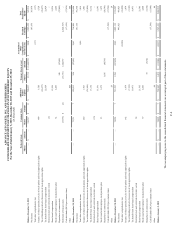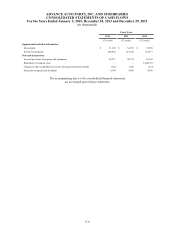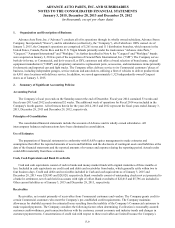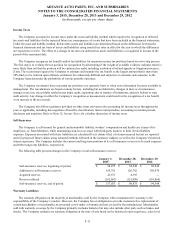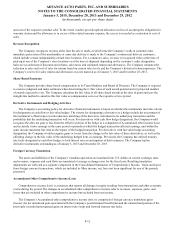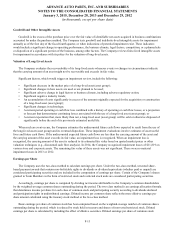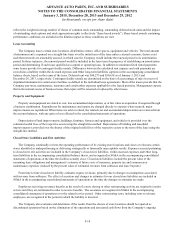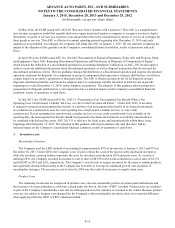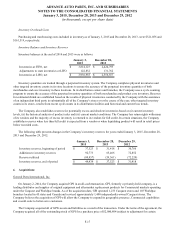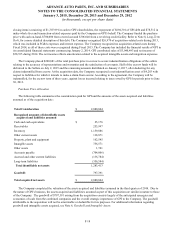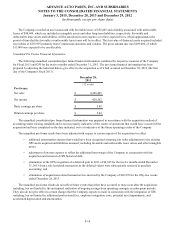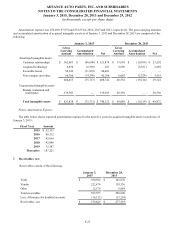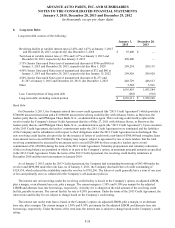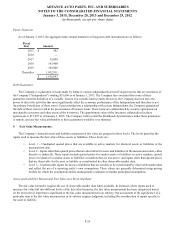Advance Auto Parts 2014 Annual Report Download - page 63
Download and view the complete annual report
Please find page 63 of the 2014 Advance Auto Parts annual report below. You can navigate through the pages in the report by either clicking on the pages listed below, or by using the keyword search tool below to find specific information within the annual report.ADVANCE AUTO PARTS, INC. AND SUBSIDIARIES
NOTES TO THE CONSOLIDATED FINANCIAL STATEMENTS
January 3, 2015, December 28, 2013 and December 29, 2012
(in thousands, except per share data)
F-16
In May 2014, the FASB issued ASU 2014-09 "Revenue from Contracts with Customers." This ASU is a comprehensive
new revenue recognition model that expands disclosure requirements and requires a company to recognize revenue to depict
the transfer of goods or services to a customer at an amount that reflects the consideration it expects to receive in exchange for
those goods or services. This ASU is effective for annual reporting periods beginning after December 15, 2016 and early
adoption is not permitted. Accordingly, the Company will adopt this ASU on January 1, 2017. We are currently evaluating the
impact of the adoption of this guidance on the Company's consolidated financial condition, results of operations and cash
flows.
In April 2014, the FASB issued ASU No. 2014-08 "Presentation of Financial Statements (Topic 205) and Property, Plant,
and Equipment (Topic 360): Reporting Discontinued Operations and Disclosures of Disposals of Components of Equity",
which amends the definition of a discontinued operation in Accounting Standards Codification, or ASC, 205-20 and requires
entities to provide additional disclosures about discontinued operations as well as disposal transactions that do not meet the
discontinued operations criteria. The new guidance changes the definition of a discontinued operation and requires discontinued
operations treatment for disposals of a component or group of components that represents a strategic shift that has or will have
a major impact on an entity’s operations or financial results. The ASU is effective prospectively for all disposals (except
disposals classified as held for sale before the adoption date) or components initially classified as held for sale in periods
beginning on or after December 15, 2014; earlier adoption is permitted. The adoption of this guidance affects prospective
presentation of disposals and therefore, is not expected to have a material impact on the Company's consolidated financial
condition, results of operations or cash flows.
In July 2013, the FASB issued ASU No. 2013-11 “Presentation of an Unrecognized Tax Benefit When a Net
Operating Loss Carryforward, a Similar Tax Loss, or a Tax Credit Carryforward Exists.” Under ASU 2013-11 an entity
is required to present an unrecognized tax benefit, or a portion of an unrecognized tax benefit, in its financial statements
as a reduction to a deferred tax asset for a net operating loss carryforward, a similar tax loss, or a tax credit
carryforward. If a net operating loss carryforward, a similar tax loss, or a tax credit carryforward is not available at the
reporting date, the unrecognized tax benefit should be presented in the financial statements as a liability and should not
be combined with deferred tax assets. ASU 2013-11 is effective for fiscal years, and interim periods within those years,
beginning after December 15, 2013. The adoption of this guidance affects presentation only and, therefore, had no
material impact on the Company's consolidated financial condition, results of operations or cash flows.
3. Inventories, net:
Merchandise Inventory
The Company used the LIFO method of accounting for approximately 88% of inventories at January 3, 2015 and 95% at
December 28, 2013. Under LIFO, the Company’s cost of sales reflects the costs of the most recently purchased inventories,
while the inventory carrying balance represents the costs for inventories purchased in 2014 and prior years. As a result of
utilizing LIFO, the Company recorded an increase to cost of sales of $8,930 in 2014 and a reduction to cost of sales of $5,572
and $24,087 in 2013 and 2012, respectively. The Company’s overall costs to acquire inventory for the same or similar products
have generally decreased historically as the Company has been able to leverage its continued growth and execution of
merchandise strategies. The increase in cost of sales for 2014 was the result of an increase in supply chain costs.
Product Cores
The remaining inventories are comprised of product cores, the non-consumable portion of certain parts and batteries and
the inventory of certain subsidiaries, which are valued under the first-in, first-out (“FIFO”) method. Product cores are included
as part of the Company’s merchandise costs and are either passed on to the customer or returned to the vendor. Because product
cores are not subject to frequent cost changes like the Company’s other merchandise inventory, there is no material difference
when applying either the LIFO or FIFO valuation method.


